
Rage Against The Machine Live
Rage Against The Machine are back in business – bringing down capitalism, globalism, and the Neo Con oligarchies… Oh, and playing some good old-fashioned, ‘turn it up to 11’ rock, along the way.
Text: Christopher Holder
Picture this, if you will: imagine there was some bizarre miscommunication and U2 and Rage Against The Machine happened to be booked on a double-bill by your local branch of the Country Women’s Association for their end of year breakup… They’re both ‘serious’ bands that demand to be taken seriously, I’m sure you agree; and, for the purposes of this illustration, both need the work. Personally, I can imagine Bono and co. sauntering in, having a chat around the urn, gently strumming a few unplugged Burt Bacharach covers before posing for photos, and leaving to a swooning chorus of ‘aren’t they nice boys’. [Cue the sound of a record needle being ripped off a Simon & Garfunkle record.] Next up: Rage Against The Machine. The truck backs up into the CWA hall and 50,000 Watts of raw audio grunt is unloaded and stacked floor-to-ceiling. And before the ladies can rinse out their teacups and saucers to make a hasty retreat, the boys rip open a fresh can of rock ‘n’ roll whoop-ass – thunderous, brutal, uncompromising, cop-this, ball-tearing, take-no-prisoners, get-out-of-my-way, ‘you-talkin’-to-me?’ rock ‘n’ roll.
This is not to say RATM don’t phone home on Mothers’ Day, I’m just making the observation that in an industry full of chutzpah and poseurs, RATM is a one-off – they know only one way to rock and that’s hard.
It’s an attitude that gels well with front-of-house engineer Robert Collins. After spending time with their previous ‘super group’ incarnation, Audioslave, Robert has signed up for this world tour.
“I love working with them. It’s great working with a band with attitude. Their sound has an attitude as well. Tim [Commerford] on the bass, for example, he’s got some sounds that are just killing. They just grab you. Which is fantastic; much better than a timid bass player just pootling about.”
Robert Collins is Welsh like really Welsh, and definitely not a clichéd LA-based tattooed rock dog and he’s prone to come out with words like ‘pootling’. Robert is best known for his regular commitments with Eric Clapton and Mark Knopfler. It made me wonder how he hooked up with RATM.
Robert Collins: The band like me for my attitude towards the sound and we clicked along the same sort of lines. And they’re happy with what they get.
Christopher Holder: And what is your ‘attitude’?
RC: Turn it up! No, just joking, that’s not true. I like to reproduce what they’re doing. I’m not a producer; I’m a sound engineer – I listen to what they’re doing and reproduce it.
CH: Is it important for you to like the band you’re mixing?
RC: I don’t think you necessarily need to like what they do but you’ve always got to have respect for what they do. When I get behind the console it doesn’t matter who they are, what they are or what they’re doing, I can find enjoyment out of reproducing it.
This year I might go from Rage, which is full on excitement, to Mark Knopfler, which is more intense, sound-wise – with more emphasis on clever little elements that need highlighting. A Mark Knopfler gig will have nowhere near the energy of even eight bars of Rage, but I can get enjoyment out of that too. There will always be days when I’ll turn around and think… ‘what am I doing?!’, but when the lights go down, I get the same feeling now as I did 30 years ago.
When we first started with this tour, Brad, our drummer, was totally surrounded by monitoring - I called it the Texas Headphones.
CH: RATM are experts at conveying that sense of unpredictable, spontaneous musical aggression. But I always figure that from a production standpoint unpredictability generally requires more preparation – having everything locked in and locked off so you can ready yourself for anything.
RC: That’s nearly true. But we sometimes quite like it when we’re out on a limb. And with this band, that can happen – where you just jump in on a system that you’ve not used before. You just have to fly by the seat of your pants.
CH: What are your priorities when you’re thrown into a situation like that? What’s foremost on your mental checklist?
RC: I don’t think of a ‘first’ or a ‘last’ thing that I need to do. For me, it’s a case of: I want to be able to hear everything all the time. I don’t want to lose anything. Subconsciously, you’ll do things to flesh out certain elements a bit better. If I stood there, concentrating on the sound of the snare drum – and I’ve seen this happen – where you’re concentrating so hard on getting that sound ‘just right’, everything else falls apart. So, instead, it’s ‘a little bit here and there’. Don’t get lost in fixing one sound. ‘Where’s the hi-hat?’ ‘Why’s the bass like that?’ I’m questioning myself all the time. Sometimes I’ll then stand back and think – yeah that’s it – and then, bang, ‘no, no it isn’t’.
CH: You’ve always got to be doing something… the mix can always be better…
RC: Yeah, I think so. For example, I sometimes EQ single words of a vocal. Literally. If the vocalist does something that really annoys me that I remember from night to night, I’ll EQ it. That’s just the way I am.
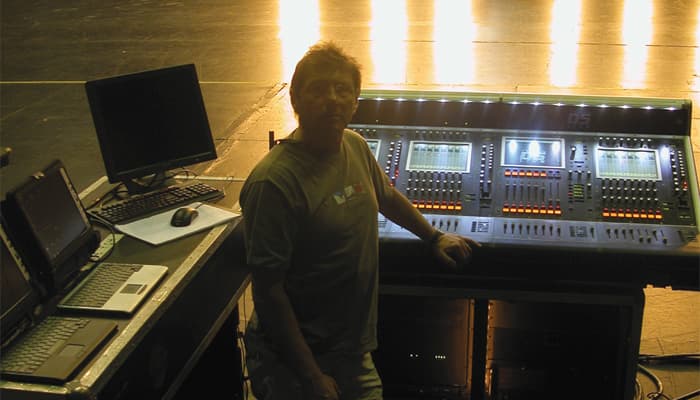
Robert Collins on digital consoles: “I like digital desks but I like analogue ones better. I think they’re more like an instrument – you can play them. With some digital desks, there’s no personality; there’s no response or feel. When you’re sitting behind a console you want to feel like you’re contributing… When you’re EQ’ing you want to be able to feel it, and not just hear it. A lot of these digital desks, it all feels a bit meaningless… and there’s just page after page, sitting endlessly at the screen. The only reason why I use glasses now is because of these bloody digital desks! I need them to make sure I know where I am. The old Midas XL4, you can do your work with your eyes closed. At least with the D5 I can set it out like a desk and use it like a desk, and it gives me the feeling that I’m doing something.
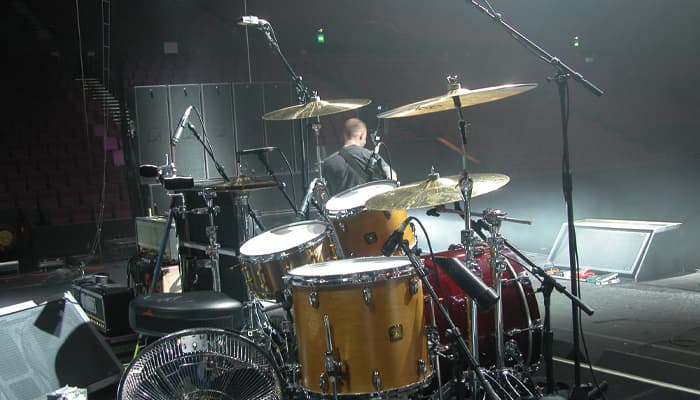
Drum Mics: Audix D4 on the toms, D6 and a Shure Beta 91 on the kick. Shure SM57 on the snare top and an Audio-Technica AT3000 on the snare bottom, “which I love”. AKG 414s on the overheads. AKG 460 on hi-hats. The drum monitor setup has been pared down to two 2 x 15 wedges. In the background you can make out the sidefill from hell – 6 x L-Acoustics V-DOSC and four SB218 subs.
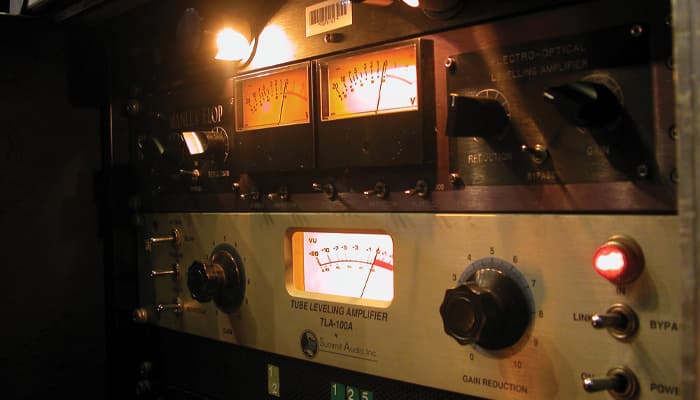
Vocal Channel: “There are three vocal channels: the main one and two spares. I run the main vocal channel through the tube levelling of a Summit TLA and that’s there more because of its big knobs and the ability to quickly grab it. The spare vocals go through either side of the Manley ELOP. Does he break his mic often? No not really, but maybe a line will go down, a cable will be pulled out… then I know we’ve got spares. Apart from that I’ve got the TC M5000 with a couple of reverb setting and a TC D-Two delay, which I play with now and again. It’s a ‘minimal’ band with a minimum of anything. No big effects, or reverbs or anything.”
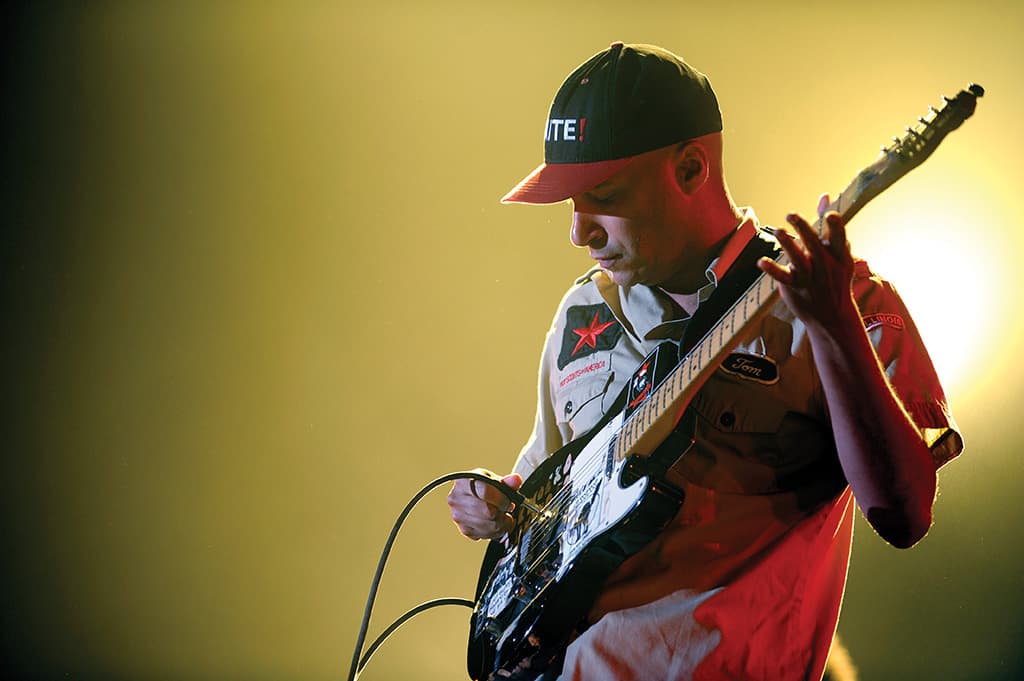
CONTROL
CH: You have a big brutal rock band playing very loudly on a stage packed with floor monitors and sidefill, performing in enormous cavernous arenas… what’s your approach to controlling the sound? Do you rely heavily on gates to clamp down on unnecessarily open mics, for example?
RC: I’ve got gates on the toms and snare but on a stage as loud as this you can’t rely on gates – the foldback and spill will keep the gates open. I like to keep the sound as natural as I can anyway, and I find the best gate and compression controls are in the ends of my fingers – I’d rather ride faders and switch channels off and on myself.
The other thing to remember is, if the sound of your mix changes because a microphone has just opened, then it should be either kept off or open all the time.
CH: What about the vocal mic?
RC: It’s open all the time. If Zak [de la Rocha, RATM vocalist] wants to say anything at any time, he can. Remember, I’m augmenting the sound, I’m enhancing the sound… I’m not producing. Which means there will be times when the spill does things that you’d otherwise find intolerable in the studio. For example, during the show you might think – ‘hmm, those cymbals got a bit loud there’. Well, it’s because Zak has just walked past the cymbals with the mic while he’s singing.
CH: Which, clearly you can’t do much about.
RC: I can’t do anything about it. And that’s why if I have gates constantly opening and closing, it’s going to change the sound. You’re going to get a little phasing thing going on, because of where they are. So I prefer to keep them open.
But the other thing to remember about achieving a tight controlled sound is: this band is really good, and I mean really good. They’ve got their sounds down pat, they play together well. That makes it all a lot easier.
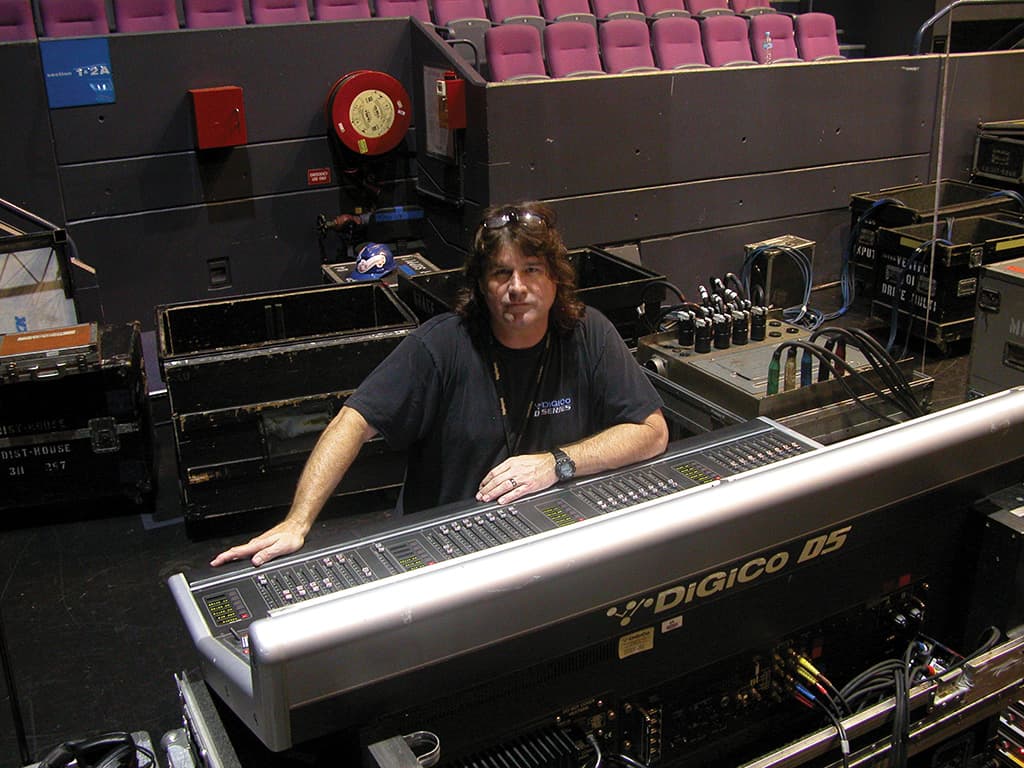
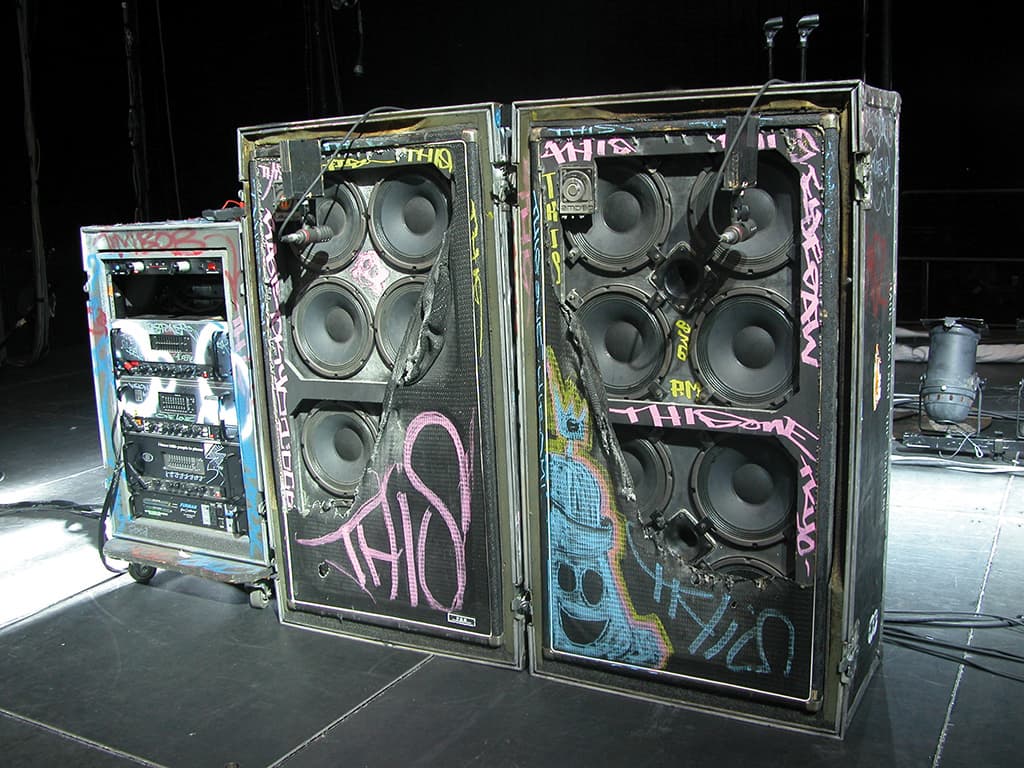
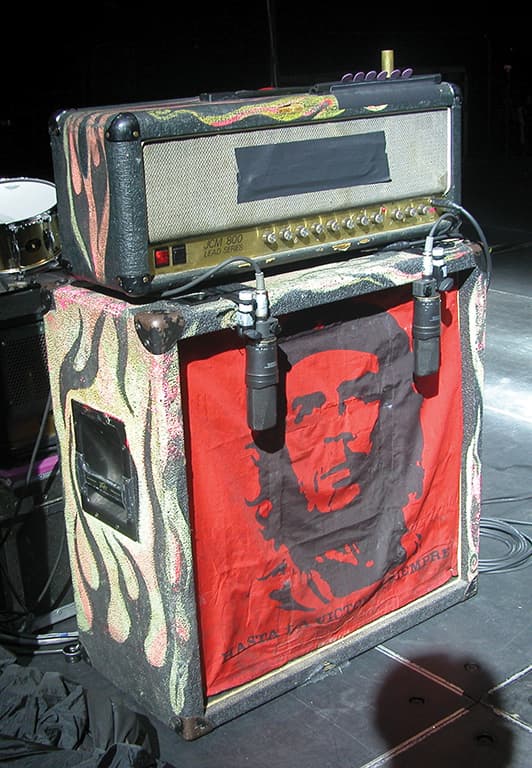
ROCK OF AGES
CH: It’s a stage setup – lots of wedges, big drumfill and sidefill – that you won’t see much in 2008 but would have been de rigeur back in 1988. But presumably, the punters are enjoying a sound far superior to what they’d hear in 1988. What are the main differences you’ve seen happen to concert sound in the 30-odd years you’ve done this?
RC: I think, more than anything else, the power amps are far better. But my answer to that question is going to be different mixing Rage than it would be mixing, say, Mark Knopfler. Rage’s sound isn’t about nuance and detail, it’s about power and energy. So, although microphones are now much better than they were 20 or 30 years ago, we still use Shure SM58s on vocals – a mic that’ll outlive us all. The same applies to the PA. For some bands, a brand new line array like Vertec will revolutionise their sound, but for Rage it’s not such an issue. Actually in America we used an older conventional PA, the Clair S4. We had that floor to ceiling – a wall of sound. It sounded amazing.
CH: Was it more painful to sonically wrangle a huge cluster of S4s?
RC: Not really. It’s only harder for the poor people who have to lift them up!
Everything we do as engineers should be about helping the band improve their performance.
CH: So do you think these days that too much is made of getting bands onto in-ear monitoring and ditching conventional trapezoidal cabs in preference to line array?
RC: Everything we do as engineers should be about helping the band improve their performance. If the band is comfortable on stage, then it doesn’t matter if their monitors are hellishly loud or super quiet. If it’s quiet on stage then it’s better for me, but if they’re comfortable with the sound being hellishly loud on stage and they play better because of that, then it’s just made my job easier. Remember: if they don’t play, I can’t do anything. This is true of all bands, not just Rage: so long as they feel comfortable up there, they feel confident in the people around them – comfortable and confident – then we will get a good show. But if they’re in a shitty mood and playing badly, then there’s nothing we can do about that – everybody suffers.
CH: And obviously a loud stage without in-ear monitors is the way Rage feels comfortable and confident?
RC: That’s right. But other bands will be different. There are a lot of young bands and musos that have learnt to play in their bedroom – most probably they recorded their first album in their bedroom – so they’re into the technology, and they’re into having a produced sound in their head. That’s where in-ear monitoring is a great thing – you can provide these musos with a CD production in their head, and they perform better because of that. But other bands, thanks to in-ear monitoring, are in their own individual little worlds. They never learnt to play together in pubs or clubs. They get very isolated, and you get fragments of a band on stage, where they don’t really play together. There will be times where the drummer might make a mistake and it’s a case of: he made a mistake and nobody else registers. That’s different to years ago, when someone in the band made a mistake everyone followed, because everyone listened to each other and played off each other. Now, four bars down the line someone will turn around and say – what happened there?!


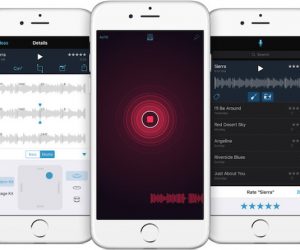
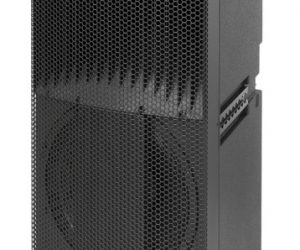












RESPONSES